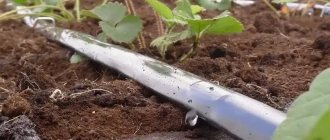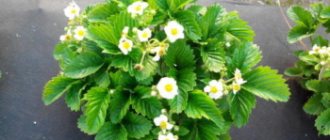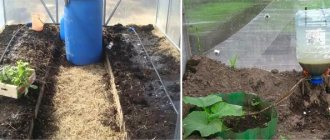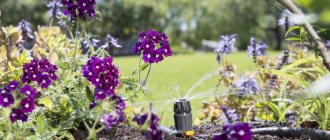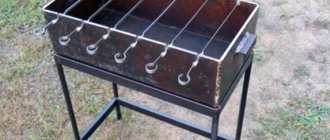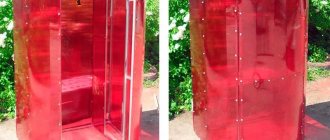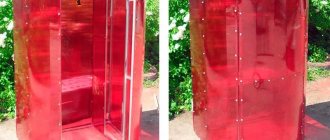The editors of the YaNashla website bring to your attention a review of the best drip irrigation systems. This tool is an indispensable assistant for every gardener. The days of manual irrigation are a thing of the past. Irrigation systems save time and effort, and high-quality tools completely automate the watering process. In addition, they are not expensive and last for many years.
Drip irrigation is organized in such a way that the soil and plants are automatically moistened. The main advantage of this garden tool is saving water. Everything works as follows. The water comes from a separate reservoir (often a large barrel) and passes through a filter and then through a hose. You can regulate the water supply through a special tap.
The drip irrigation kit consists of the following parts. The main part is a drip tape, on which (at a certain distance) there are holes for water. There is also a hose tube, filters for water purification and various small items.
Advantages:
- low price;
- variety of system configurations;
- Irrigation of beds and greenhouses at any time;
- assembly does not require special knowledge;
- ensuring uniform soil moisture;
- protection of plants from damage;
- crop improvement;
- does not require human presence.
Uniform automatic watering helps not only to increase the quantity of the crop, but also its quality. With such watering, the weeds are not saturated with moisture, so they hardly grow, and when fertilized through drip irrigation, the nutrients are absorbed much better.
There are several types of irrigation systems. They differ in functionality and structure of the device. In general, all systems are divided into 2 groups:
- Automatic.
- Not automatic.
The former do not require the presence of a gardener, since they are pre-programmed for the irrigation time, while the latter require his presence - the summer resident needs to turn the water on and off with his own hands, as well as regulate the pressure.
2 more types:
- With drip lines. This invention is a rigid long hose that is resistant to sunlight. Droppers are installed along its entire length, each of which fits one plant or one bush. These drippers can be adjusted automatically using a cap, or they can dispense a fixed amount of water per hour. There are two types of irrigation with drip lines - compensated and uncompensated. The first take into account the surface, slopes and amount of pollution. The latter are more suitable for ordinary beds with flat terrain.
- With drip tapes. Suitable for uniform beds where plants are spaced evenly apart. Since the tape itself is polyethylene, it is not durable. It will have to be replaced after 2-3 years.
Experienced gardeners often install such systems themselves. This requires a water tank. It can be pumped with water or collected from the roof. A pipeline is connected to this tank, and from it there is a hose that branches out across the beds.
You should calculate in advance the daily volume of water that is necessary for normal hydration of plants. For large bushes and trees, it is better to install several holes, as they require more liquid.
A timer for regulating the time and volume of irrigation can be found in a gardening store. It runs on batteries and has 2 scales. On one, the duration of irrigation is adjusted, on the other, the frequency.
The first stage of assembly is connecting the pipe with the filter to the water container. Then you can set a timer and connect all the remaining pipes. Now the entire system is laid out in such a way that irrigation is carried out evenly.
In order for a homemade tool to serve for a long time, it is important to adhere to the following rules:
- Clean the filters of debris once a week or two.
- When using fertilizers in a system, it is better to use easily soluble ones. Afterwards, be sure to rinse everything with clean water.
- Before cleaning the system for the winter, it must be thoroughly dried.
When choosing this garden tool, you should pay attention, first of all, to the type of system. Which one will be convenient specifically for this vegetable garden or garden, and for this seating arrangement and type of beds.
The thickness of the walls of the drip tape is something that is worth paying attention to. The lifespan of the entire mechanism depends on it. The thicker the tape, the more resistant it is to external damage. Standard tape sizes are 5,6,8,10 and 15 miles.
Another important detail is the distance between the irrigation holes (“tape pitch”). The minimum distance is used for plants that are planted close to each other - these are onions and dill. The maximum distance is necessary for irrigating potatoes.
The operating pressure is selected based on the wall thickness of the tubes. The greater the pressure, the higher the likelihood of damaging the tapes. You should also choose based on water consumption.
Drip irrigation for a greenhouse: secrets of homemade structures
Let's figure out how to make drip irrigation. In this case, it is advisable to perform automated irrigation. When deciding how to properly water, you need to take into account that different crops require different amounts of water.
The diagram shows a simple design of drip irrigation
It is important to know how much water is needed and which plants, because oversaturation of the soil can lead to the opposite effect and depletion of the soil. This will cause the weeds to grow faster.
The drip device has the following features:
- In order for the plant to develop properly, it needs a sufficient amount of air. What regular watering does not provide. If there is no air movement at the root, then the culture will not develop as it should;
- the liquid penetrates directly into the root of the plants;
- the optimal ratio of air and humidity contributes to the proper development of plants, which makes it possible to do without fertilizers.
Simple watering design
Before deciding how to choose such an irrigation system and how to use such a design, it is necessary to study the principle of operation of the design. Depending on equipment options, the liquid may move by gravity. In this case, a gravity irrigation design is used, that is, water flows in as soon as the barrel is filled. There is also a forced version of the device. It is important to decide which pump is needed and whether a filter is needed. It is important to know what pressure is required for such a system, since many similar designs from the manufacturer are designed for a pressure of no more than 2 atm. In this case, such a pressure regulator is installed - a reducer. A hose or drip tape can also be used. Water in the area moves through pipes with branches. In this case, special fittings for drip irrigation are used. Main pipes are laid along the walls of greenhouses or along fences.
The diagram shows a simple barrel irrigation system
The photo shows spot irrigation, including drip lines that extend along all lines of the beds. Similar lines are made using a plastic pipe or drip tape with holes. At the end of such lines, plugs or flush valves are attached.
You also need to decide whether a special filter is needed. The water supply is regulated using a reducer and a valve.
Dot pattern requires more installation effort
How to assemble irrigation structures also depends on the required volume of the irrigation tank. To correctly calculate the capacity, you need to multiply the area of the site by 20 liters. This is the amount needed to moisten one square meter.
Watering rates for different crops can vary greatly
How much to water depends on what crops are being irrigated. For example, cucumbers and tomatoes require completely different conditions. High air humidity is harmful for tomatoes, as such vegetables become infected with fungal and bacterial diseases. Therefore, dry air is maintained in greenhouses, to ensure which ventilation is often arranged. But for cucumbers you need to create a high level of soil and air humidity. If there is a lack of moisture, the leaves can quickly begin to wither.
Here's how the drip irrigation design works:
- the water passes through the filter. At the same time, it is cleaned of debris, large debris inclusions and dust;
- since the container is located on a hill, the water flows by gravity into the main pipe and then through the hoses;
- A valve is placed near each plant through which water penetrates into the soil.
The diagram shows the operating principle of the device
For your information! To ensure better watering, you need to place the plants at a distance of 30 cm from each other.
Related article:
Do-it-yourself greenhouse made from a profile pipe. A separate review provides detailed instructions for the design and construction of a structure from a profile pipe with photo examples.
Distance between outlets
Another important factor to consider when choosing drip irrigation is “tape pitch.” It is selected based on the needs of the crop being grown.
Melon crops require a large distance between holes - from 40 cm, a step of 30 cm is optimal for tomatoes, cucumbers, strawberries, and potatoes. A distance of 10-20 cm is suitable for densely planted plants such as garlic, parsley, lettuce, and onions. This tape is also used for sandy and light soils; here the ground is literally moistened with a continuous line.
Types of irrigation: different systems
Now let’s figure out what the main types of drip irrigation are. Each system has certain disadvantages and advantages. Here are the main options:
- For automatic watering with separate drippers, branches are supplied to each plant. In this case, the irrigation radius should be small, since such unfolding takes a lot of time. The main elements of such systems are microtubes through which liquid passes to the root system. For installation in a greenhouse, splitters, special valves and racks for fastening microtubes are used;
Option for distributing elements in automatic watering
- drip tapes are used not only for plants, vegetable gardens, but also for trees. In this case, the sprinkler pipes are placed in parallel. Such irrigation methods do not have as long a service life as individual spray drippers. For automatic watering of fields, each tape has holes through which water flows. One edge is placed at the tank, and plugs are mounted on the second. This ensures that the liquid flows out against the desired roots.
Irrigation system using tapes
Also, when choosing an irrigation system, you need to consider different types of hoses, types of sprinklers and sprinklers.
Drip irrigation: pros and cons of designs
There are different options for watering plants in open ground, but they are not always suitable for greenhouses.
The drip system has the following advantages:
- increasing the yield of different crops;
- water is distributed in certain dosages, which ensures the efficiency of this design;
- you can create a fully automated process;
- the threat of erosion of the soil layer is reduced;
- resistance to different climatic conditions appears;
- the possibility of uniform distribution of fertilizers is provided;
- the quality of grown crops improves;
- it becomes possible to water large areas at low pressure;
- Ease of Management.
Drip type design diagram
There are other important advantages. For example, saving water allows you to ultimately reduce the cost of the final product. A drip design set installed in a greenhouse significantly reduces the consumption of water and fertilizers. The optimal amount of moisture must be observed for some crops, especially tomatoes. You can buy different devices for dosing watering.
Sprinkler system option
All the advantages and disadvantages of different irrigation options are presented in the table.
Table 1. Advantages and disadvantages of different irrigation options
| Type of irrigation | pros | Minuses |
| Root | This is done using a simple watering can. At the same time, you can apply fertilizers. | The procedure is complicated because it requires a lot of time |
| Watering the beds | Watering is easy, since you just need to lay the hose, and the liquid will spread on its own. | Inconvenient when moving between trenches with plants. |
| Sprinkling | Uniform water supply process, as well as the ability to adjust the pressure. | Installation is too complicated. The formation of high humidity in the greenhouse, which can provoke the appearance of various diseases. |
| Drip method | You can regulate the water supply. Ease of use and water saving. The process distributes fertilizer evenly. | Complexity of installation and high cost of individual elements. |
Farmer-2
This model is considered the best in terms of the set, which includes all the necessary parts and accessories. The device is manufactured in Ukraine and has been on the demand market for quite some time. The model is suitable for irrigation of an area of 20 square meters. All parts are UV resistant and can withstand water pressure up to 1.1 bar.
Pros:
- Good set of components;
- Affordable price;
- Good quality;
- Easy installation;
- Resistance of parts and housing to ultraviolet radiation.
What does drip irrigation consist of: the main elements of the device
To build a drip structure yourself, you need to buy separate elements.
Individual elements for drip irrigation and their prices
All parts are connected in series to each other:
- disk filter;
- main pipe;
- a mechanism for enriching water with nutritional components;
- drip tapes;
- start connectors for connecting drip tapes;
- splitters for drip tapes;
- plugs for tapes.
Set of components for watering structure
Tape for drip irrigation: application features
A drip tape is a hose through which water moves. In this case, the liquid is purified using different filters. When determining which tape is better, you need to take into account certain characteristics. It is important to calculate the length of the drip tape, as well as the thickness of its walls. Operating conditions depend on these parameters. The distance between the tapes also matters. In this case, the best tape depends on the timing of plant ripening.
Special tape in a coil for self-installation of the system
You need to know how to mount the tape yourself. A drip tape is installed on the pipe, which is tightened with a special nut. To install such a structure, fittings are used. It is with their help that branching is carried out. To perform strip irrigation, such a structure must be mounted so that the holes in it are placed on top.
Complete set with fittings
Watering tape can be different. Here are the main types of drip tapes:
- Outdated technologies include labyrinth-type tape . A continuous labyrinth is formed along its entire length, through which water moves. This option can be purchased inexpensively;
You can watch a video about this technology:
The labyrinth design has a specific structure
- slotted tape is more reliable than labyrinth tape. There is also a labyrinthine channel inside it. In this case, it is necessary not only to decide how to lay this element, but also to apply a special filtration system;
Slit product option
- According to reviews, emitter-type production is a modern solution. Irrigation is carried out using flat droppers. The emitter tape creates currents that move water.
Emitter type products
To purchase such an element, you need to know how to lay it correctly and how much such tape costs. The drip system completely depends on the quality of this element. An important indicator is the price. The Tuboflex system deserves special attention; its cost varies between 2500-3000 rubles.
Tuboflex products
Start connectors for drip irrigation: how to use
To make functional drip irrigation you need to buy a starting connector. Installation for the tuboflex system is performed as follows. Using a marker, the surface of the main pipeline is marked for holes. At the same time, connectors and a starting valve are mounted to them. First, seals are placed in the holes, and then start connectors.
It is worth considering the principle of operation of the device with a tap. This connection diagram allows for manual adjustment. This is important if your greenhouse contains different crops with their own watering needs.
This is what standard start connectors look like
Irrigation drippers: manufacturing technology
For drip irrigation, you can build a structure with your own hands. You can see how to do this in the video below:
This can be a collapsible and compensated model, as well as an adjustable design with water supply control. The dripper irrigation system ensures uniform pressure on different parts of the hose. This ensures uniform watering of the plants.
A similar compensated model can be purchased in the store
You can use medical IVs. Watering indoor plants can be done from a plastic bottle. To make drippers in greenhouses, you first need to install a container and fill it with water. It is also necessary to install a hose and a submersible pump. It is important to calculate how much water you will need. For a tomato bush, 1.5 liters per day is enough, and for cucumbers – 2 liters. The dropper can be made in the form of a tape. This option is suitable if watering is designed for different crops. For example, for flowers and vegetables.
Submersible pump option for drip irrigation
Before installing droppers, it is necessary to make some calculations. If external compensated drippers are installed, then to determine the water flow, the soil is checked for depth after an hour. The price of the structure also depends on this indicator.
Assembling a drip irrigation structure
Types of drip irrigation: prices and purchase features
A drip irrigation system is a durable and reliable option. Operational periods can exceed 10 years. To equip a strip structure for greenhouses, a watering strip is used, which has many holes, as well as a wall thickness of up to 200 microns. Such a hose is attached at one end to the water supply, and a plug is placed at the other end. When water penetrates, liquid comes out of the holes.
When deciding which system to choose, you need to take into account that the irrigation supply cannot be regulated. This option differs from spot irrigation, since it will not be possible to provide irrigation to individual points.
The automatic mechanism is most often combined with a hydraulic valve. In this case, a controller with a timer is used, with which you can even set the exact watering time. Knowing how such a system works, you can use the same principle to install self-watering systems with your own hands.
Let's look at the best irrigation systems that have an automatic machine. To determine which option is better, you need to consider them all:
- watering using sprinklers . This kit allows you to provide an irrigation radius of up to 20 meters. In this case, polypropylene pipes are used. Sometimes polycarbonate structures are used. This irrigation design increases soil and air moisture;
Sprinkler options
- For sprinkling, special drum devices . They are mobile devices. Watering of plants is carried out over an area of 20 square meters;
Automatic option with sprinkling
- For large areas, wide-coverage systems ;
Industrial scale structures
- Micro-sprinkling is used in several greenhouses . Watering can be done from a barrel. In this case, a special flexible hose is used.
Micro-sprinkler device
With proper calculations, a homemade watering device will provide high-quality spot watering. In this case, water consumption can be minimal. Where you can purchase such structures depends on the characteristics of irrigation. Our review of individual models will help you choose the best option.
Table 2. Average cost of drip irrigation
| Models | Image | Characteristics | price, rub. |
| Hose Gardena 01969 - 15m. | Suitable for directional watering. Can be used even at low pressure. Warranty period is one year. | 1900 |
| Water strider system "Eco Volya", 4m | Provides gentle watering on the site. Can be used both in open ground and in greenhouse conditions. Water moves in small portions to the root systems using drippers. The set includes a special water filter. The main set is designed for two beds, the length of which is 4 meters. | 1400 |
| Drip irrigation “Beetle” for 60 plants | The set is designed for micro-irrigation. Allows you to organize the necessary nutrition for different plants. Made from quality materials. The hose can be easily guided to the watering site without twisting or bending. Plastic and polyethylene are used in production. The package includes all parts for fastening, as well as a filter for fine cleaning. | 1800 |
| System without automation "AquaDusya" | The system can be connected to any container that needs to be installed at a height of a meter. In this case, the water can warm up naturally. The liquid moves through the hoses directly to the roots. In this case, pencil-type droppers are used. A branched tee can be installed on the faucet. The design is capable of producing up to 1.5 liters per hour. | 1900 |
| “My Hacienda” 100 m | The design is designed for 100 meters of beds. The kit includes drip tape, faucet, plugs and fittings. The system operates from water supply and from a regular barrel. | 1790 |
| "Drop" design | The design consists of a tape, a regulation tap, plugs and adapters. Such a system can be turned on for 1.5-2 hours a day. The garden uses up to 40 liters of water per day. You can assemble the structure yourself. | 1490 |
Drip irrigation for the Zhuk greenhouse: characteristics
This system is known for its functionality and efficiency. You can use a greenhouse or greenhouse kit. A similar watering kit can be used for a greenhouse or an open area. You can buy a similar design from, which produces it.
Complete set of watering device
Installation of the greenhouse option involves processing 60 plants. With its help you can process a room with an area of about 18 sq.m. The barrel model will cost about 1.8 thousand rubles, and the version for water supply will cost 2.5. Installation of a greenhouse structure can be carried out in various ways. You can use the automatic option with a timer.
Automatic design
Drip irrigation AquaDusya: device parameters
The AquaDusya system is designed for 50-60 plants. You can purchase an automatic start option or a model without automation. There is also a semi-automatic mechanism. The advantages of such equipment include the ability to operate on batteries and small design dimensions. You can install the machine and other variations yourself. At the same time, the Start design can provide high-quality watering without the presence of people. There is an option for connecting not only to the water supply, but also from a barrel. The price will depend on this.
Basic equipment of the model
Drip irrigation in greenhouses: user reviews
When choosing which watering is best for a greenhouse, it is worth studying all the options and reviews. Manufacturer ratings will help you choose the best option.
Review, Zhuk system
Vladimir, Ryazan: “The advantages of the equipment include high-quality materials and assembly. The kit includes a water strider, filter and timer. You can water from a barrel. One of the minuses I would like to note is that the water meter tube in the package is so bent that it never straightens completely. But overall, the design is wonderful. It works like clockwork.”
Review by Gardena
Alexander, Penza: “I have been using the gardena drip irrigation model for several years. The design is made with high quality. Good watering area at normal pressure. Don't forget to clean the injectors regularly. You also need to insert a mechanical filter and drain the water in a timely manner.”
Review by AquaDusya
Alina, Krasnodar: “Last year my husband bought an automatic Aquadusya system. We purchased a kit for greenhouses. At first we wanted to choose a German watering design, but the domestic version also does a good job and at the same time has a lower cost. Installation of the structure was not difficult. The area of our greenhouse is 40 square meters, and next to it there is a tank of 50 liters. The droppers are evenly distributed over the greenhouse area. My husband and I were pleased with this system. As a result, we received a rich harvest.”
Water purification process
If you use dirty water for irrigation for a long time, the drip system may not last even one season. The middle of the season is especially risky in this regard, when the drip holes quickly become clogged with dirt. For an emitter line, this issue is less critical than for a slot line.
It is worth remembering that the less liquid is consumed by the dropper, the thinner the channels for releasing liquid should be, which means more thorough filtration is required. In this matter, you can focus on the following indicators:
- The liquid flow rate in the dropper is less than 1 liter per hour - increased filtration is required due to the extremely thin water outlet channels;
- The liquid flow rate in the dropper is more than 2 liters per hour - this tape is less sensitive to the quality of the liquid.
DIY drip irrigation system for a greenhouse
Drip irrigation allows for good treatment of the root system. Such a device for a greenhouse allows you to preserve the beneficial qualities of the soil layer as much as possible.
Since automatic equipment is quite expensive, it is better to figure out how to make homemade watering. The organization of such a structure is not so difficult. Water passes through the capillary path and enters each plant root system.
The diagram shows an option for installing an irrigation structure
Installation is carried out using staples, self-tapping screws, plugs, adjustable wrenches, and pipe cutting scissors. To create high-quality self-watering, you need to find medical droppers, a connector, nozzles, drip tapes, pipes and switch taps. A modern watering system involves the use of a timer. It is better to choose elements made of plastic, which, unlike metal, do not rust or clog.
Simple design of a self-watering system
If you don’t know how to install the structure yourself, then start with a plan for placing the beds in a greenhouse or greenhouse. Variants of such layouts can be seen in the photo. The diagram must contain all important parameters. The source of water must be identified. When organizing drip irrigation, you need to mark the container to which the pipeline will be connected. In this case, spot watering can be performed without your participation.
A point device allows you to water each individual bush
If micro-irrigation is installed, a filter system will be required. Such a device may be located between the water source and the desired main line. The point version is used for tomato seedlings. Since in this case, excessive hydration is very harmful. For tomatoes, subsoil irrigation is also used.
Micro-irrigation option for different crops
The hose can be connected to the main pipeline using special fittings. The filter is most often mounted in the supply pipe.
The diagram shows where the filter is located
Installation of drip irrigation
When deciding how to organize irrigation in a greenhouse, it is necessary to draw a drawing of the system. The diagram is drawn up after taking the necessary measurements, taking into account the scale.
How to properly build a drip irrigation system depends on the calculations made. Here's what you need to calculate:
- total length of drip tape;
- number of start connectors;
- number of T- and L-shaped splitters;
- number of fittings and plugs.
Organization of the structure after calculations involves an increase in the number of consumables and drip tape by approximately 15%. Also, after calculations, a barrel for irrigation is selected.
To determine how to install irrigation elements, you need to note where crops with different water needs will be placed. In this case, the installation must be carried out in separate zones.
Now let's look at the step-by-step installation of the irrigation structure. For manufacturing you will need a liquid reservoir, a main pipe, medical droppers, filters, fittings, plugs and a ball valve. It is better if the water container is at a certain height, for example 2-2.5 meters. In this case, you need to take care of the stand.
Table 3. Installation of drip irrigation
| Image | Installation stages |
| It is necessary to make holes for water outlet in the container. First, a hole is made to install the ball valve. This element is mounted using a coupling and seal. | |
| Holes should be made in the hoses where droppers can be placed. | |
| A hose is connected to the tap. This can be done using branch fittings. | |
| Branches from hoses are laid between the rows. | |
| It is necessary to install plugs at the end of the main pipes to prevent water from spreading. | |
| Remove the needles from the droppers and leave the rubber tips. | |
| The tips are inserted into the holes made in the hoses. | |
| The tips of the drip parts are stuck into the soil next to the plants. | |
| Then you need to open the tap and check how the structure works. Using the control wheel, you can control the flow of liquid into the soil. |
Main pipe for drip irrigation
A main pipeline is made in the greenhouse, which supplies water from the source to the start connectors. Before choosing which pipe is better, you need to calculate the length of all pipes.
It is better to use polyethylene pipes as the main pipe. It is necessary to determine what diameter is needed for such highways. For example, a HDPE pipe should have a diameter of 32 mm. A smaller diameter is not suitable, since a 16 mm hole is drilled in the pipes for the start connectors. A screwdriver is used for drilling. How to make such a structure with your own hands depends on the materials.
This is what the main pipe looks like
You can also use structures made of PVC pipes, polypropylene pipes or metal-plastic pipes. All such options have good contact with water and do not interact with the chemical components of fertilizers.
When choosing a dacha option, an important parameter is the price. Tees are installed in the outlet areas of the lines, and a drip hose or tape is connected to their lateral flow. Sometimes a leaking hose is selected.
This is what a leaking pipe looks like
These elements are attached to pipe fittings using metal clamps. A tap is installed on each distribution line, with which you can turn off the lines. If you don’t want to choose individual elements from plastic pipes, then you can purchase ready-made kits that can be used for summer watering.
Variations of summer designs
Venturi injector
To apply fertilizers, a special fertigation unit is used, also called a Venturi injector. You can buy a similar fertilizer device or make it yourself. The operating principle of this mechanism is to mix water with fertilizers. Installation of such a design is necessary for the gradual supply of fertilizers into the main pipe. This feeding unit consists of a hose, filter and injector.
Connection diagram for such an injector
To decide how to choose such a device, you need to know its characteristics. To install a drip irrigation structure, preliminary calculations are required. In this case, the device diagram is taken into account.
Features of the installation of such a design can be seen in the video below:
The diagram shows the operating principle of such a design
To make a homemade mechanism, you must meet the following conditions:
- direction of fluid movement. The purchased version of the injector has an arrow indicating the correct direction;
- moved flow through the injector;
- inlet pressure indicator, as well as the difference between outlet and inlet.
Most often, such injectors are made with a bypass. They are made from plastic that is resistant to various chemical fertilizers. Special adjustment allows you to reduce water consumption at the inlet, as well as turn off part of the irrigation system. There are different options for such designs, for example, 1 inch or 2 inches.
Filter for drip irrigation
Different types of filters are mounted on the pipe after the feeding unit and before the start connectors. You can see how to install and connect such a structure with your own hands in the video:
Installation is carried out taking into account the direction of water flow. It is important for the system how the filter element will be installed. To install filters in the main pipe, special couplings with adapters are used.
Installing a filter in a watering system
When deciding which filter to choose, you need to understand their purpose. They are designed to protect against damage and blockages of certain elements. If there is no filtration system, the garden hose, dispenser or pump will clog faster. In order not to waste time thinking about how to clean such parts, it is better to take care of the filters.
Many drip irrigation kits are pre-equipped with a variety of filter devices
Before purchasing a specific option, you should look at them in the photo, and also read reviews about their work. An important parameter is price. There are filters for coarse, deep and fine cleaning. Deep cleaning devices include a disk or mesh filter.
Filter with cartridge
The cartridge depends on the filtration option. It is the main filter element. It is he who determines the design option: sand, gravel or cyclone. There are stations that combine deep and coarse cleaning. You can make a homemade version.
Automatic watering in a greenhouse
You can install an autonomous drip option for watering the beds with your own hands. An automated system can function without your participation. To create auto irrigation, you need to purchase a water container, for example, for watering from a barrel, a timer, a controller, a hose and a pressure regulator. Automation can be purchased.
Full automation implies uninterrupted water supply. The water reservoir is located at a distance of 0.5 m from ground level. A pipeline is connected to it, which goes to the fertigation unit. An important component of automatic watering is a special controller.
Option for an automated system for a greenhouse
Drip irrigation materials
To decide how to make a drip irrigation system with your own hands, you need to select suitable materials. To organize watering in a greenhouse, you will need the following materials and tools:
- HDPE pipes with a diameter of 40 mm;
- pipe plugs and valve for the greenhouse;
- filtration equipment;
- container, water tank;
- nozzles and other control fittings;
- shut-off valve kits;
- watering tapes;
- Here's what you need from tools - drills, drill, rubber seals, awl, silicone sealant.
Basic set of materials for drip irrigation
The design of drip irrigation can not only be purchased, but also constructed from scrap materials. Here are some design options:
- drip irrigation with medical droppers. You will also need hoses and adapters with connections. How to equip such structures depends on water consumption. If there is a water supply system on the territory, then the channels are connected to it, and if it is net, then the water is supplied from a barrel by gravity;
Drip tapes with droppers
- A high-quality watering system can be made from plastic bottles . Holes are made in the walls of the container. Water passes to the root system through bottles;
- Spot watering of plants is often used. This option may contain an injector.
Design with plastic bottles
It is better to place such structures under covering material. Drip irrigation may or may not have a pump.
Related article:
DIY polycarbonate greenhouse. Drawings, types of structures, step-by-step construction and much more in a separate publication on our portal.
Operation of drip irrigation
After installation of all elements, the system is started. In this case, drip tapes should not have plugs at the ends. Turning on the system should be accompanied by free flow of water. At this time, the structure of all taps and automation in the greenhouse is checked.
Installation of the structure involves marking out the irrigation scheme, according to which the design of individual sections is carried out.
After connecting all the nodes, the operation of the structure is checked
A test run allows you to consider indicators such as operating mode, operating principle and operating time. Drip irrigation allows you to optimize the growth of various crops. The most important task is to plan all work on the operation of the structure.
If the operating mode is set incorrectly, the system may fail, which will cause additional costs. With an automated irrigation system, human presence is not necessary. It is only necessary to clean the parts from clogging from time to time. With this method of watering, the liquid goes directly to the roots, and the evaporation of the liquid is not so intense.
Before work, check the strength of all connections
When water passes through drip irrigation lines, it has time to heat up well, which allows you to connect the system not only to the water supply, but also to a well or to a well. The length of the lines is important, as is the operating pressure in the system.
The outlet temperature should not be more than 18 degrees. If the water is not too warm, then a buffer tank is used. The advantage of drip irrigation is that it soaks the soil layer, which gives the root system the opportunity to breathe.
How to water plants evenly and sparingly
All your efforts to moisten the soil of your summer cottage or garden and orchard will be reduced to just turning the tap lever if you take care of installing a drip irrigation system.
What is such a system, can it be used everywhere, what are its advantages? In this article I will talk not only about this, but also try to present a lot of other interesting information about the modern method of watering for amateur and professional gardeners and gardeners.
Such information will be useful for them, since drip irrigation systems have proven to be particularly effective in growing orchards, vegetables and flower beds. When water consumption is halved, the yield increases by 40-50%, and soil salinization is eliminated.
